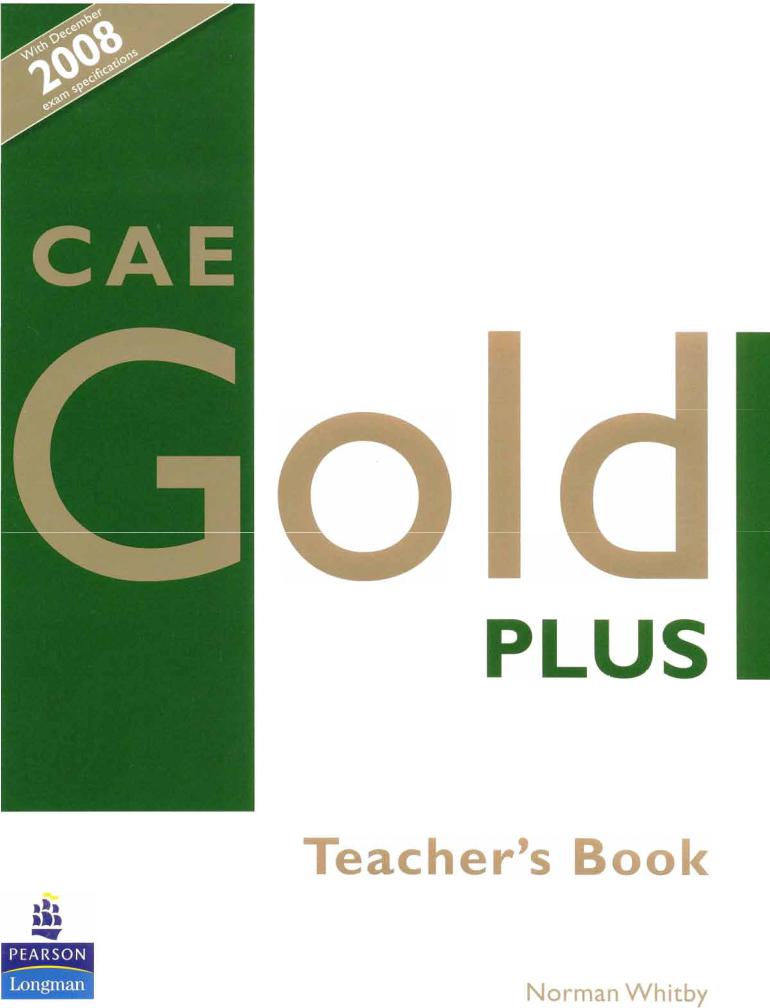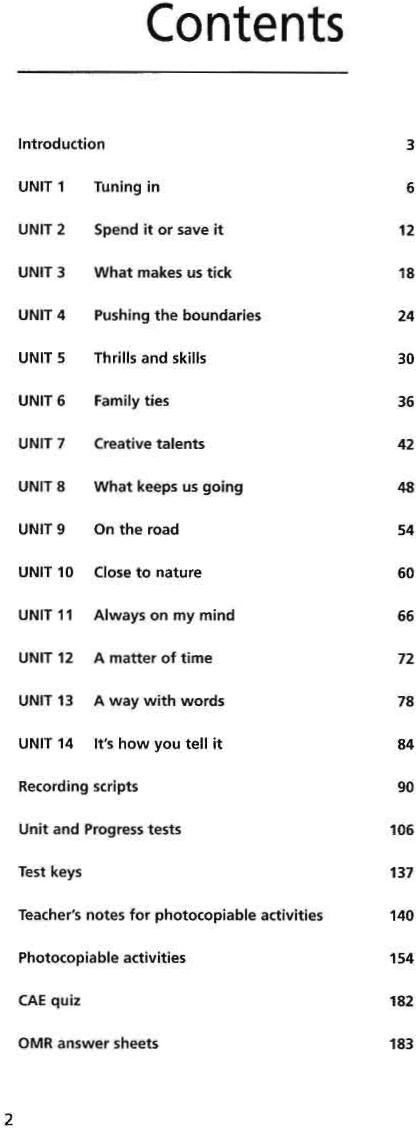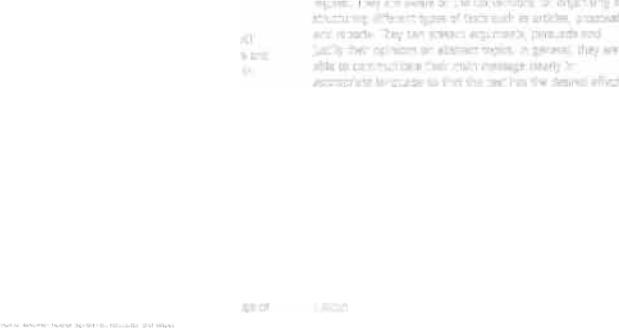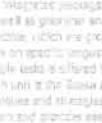
CAE Gold TB
.pdf



Particular attention is paid to word formation, which builds students'understanding of how prefixes and suffixes are used, followed by regular practice. This is particularly relevant for Paper 3 part 3.
Reading
Authentic texts from a range of sources are used to develop reading skills and techniques for CAE. Students are encouraged to use the titles and subtitles of the text as well as any non-textual information, such as accompanying photographs, to help them predict the content Guidance is provided to help them do the task and apply appropriate strategies. Vocabulary and discussion tasks after the reading texts allow students to develop the topic further and to focus on key vocabulary from the text
Listening
The listening texts are also from a range of sources and the recordings present students with a variety of mild accents. Students are always reminded to read through the task before they listen to help them predict what they might hear, and tips and guidance are often provided to help them complete the task.
Writing
Each unit ends with a writing task of a type found in the CAE exam. The section is cross referenced to the Writing reference at the back of the book which provides model answers for each of the text types. In each case students are encouraged to read the task carefully, thinking about the intended reader, and what needs to be included. They are guided towards an understanding of the various conventions of the text type, such as register, layout and typical organisation of ideas. They are then presented with a model answer, which is often used for further language work. Finally, they are given the task of writing a similar text themselves, which can be done either in class or as homework.
Speaking
The grammar, vocabulary and skills sections all provide some opportunity for speaking practice by asking students to respond to the topic or text
Each unit also contains a section with specific speaking practice for Part 5 of the exam. This presents language for such functions as agreeing and persuading as well as techniques such as how to keep the conversation going.
CAE Gold Plus maximiser
Another major component of the course is the CAE Gold Plus maximiser. Working through the exercises in the maximiser will help students to consolidate the language and skills presented in the Coursebook and provide them with further exam-specific practice and prepa~ation.
Introduction
Each of the 14 units corresponds thematically with the units in the Coursebook. The sections within each unit are crossreferenced to the related Coursebook sections and provide consolidation both of language and of skills work. The grammar and vocabulary sections also recycle material presented in the Coursebook, which is then practised further by means of topic-related exam-style Use of English (Paper 3) tasks. Sections containing exam-style tasks provide information about the exam, plus strategies for tackling each task type, and give students the opportunity to put these into practice.
The maximiser can be used in class in tandem with the Coursebook as a means of providing further work on specific grammar or vocabulary areas or, alternatively, students can do the exercises and skills practice for homework.
CAE Gold Plus CD-ROM
The CD-ROM provides a variety of exercises to recycle and extend grammar and vocabulary areas presented in the Coursebook. The sections again correspond thematically to the units in the Coursebook and many of the exercises, such as multiple-choice gapfills, are in the style of the CAE exam. The CD-ROM can be used in tandem with the Coursebook to provide further grammar and vocabulary work or it can be used as self-access material.
CAE Gold Plus teacher's book
The teacher's book provides suggestions on how to use the material in the Coursebook to best advantage. Answers to all the exercises in the Coursebook are found at the end of each section of notes. Recording scripts to all of the listening tasks are also provided. Teaching tips and ideas provide suggestions for further activities to practise the material or develop study skills. There is also a section of photocopiable activities which provide extra communicative practice in key areas of grammar and vocabulary from the Coursebook units. Many of these are directly related to exam-style tasks. Detailed teaching notes state the aims and rationale of each photocopiable activity and provide a step-by-step procedure for using them in class.
You will also find a bank of 14 photocopiable tests made up of 11 unit tests and 3 progress tests. The unit tests are based on the language covered In a single unit and should take no more than 30 minutes to complete. The progress tests are to be used after your students have completed units 5, 10 and 14 and should take between 50 and 60 minutes to complete. They revise and test the language covered in the previous four or five units.
5

fef in live music gigs, and'wondered whether
(9) A'li~l:tt yoloJ you might like to come with me to the open-air concert in the park next Saturday? It'll be great, and all the others are going . Let me
(10) know +t what you think - but unless I hear
from you by Friday "II assume you can'tmake it. I'm attaching some information about the concert with this ema il so that you can see who is playing, and we can get the tickets on the night.
So that'sall for now - speak to you soon . All the best,
Jose
Reading: multiple matching (Part 4) p.8
Aims:
•to practise gist reading to identify the focus of each section
•to complete an exam-style reading task (Paper 1, Part 4)
•to give practice in inferring word type and meaning from context
•to use a dictionary to find example sentences and collocations
1 2 Write the term tribute band on the board and ask st~dents if they know what it means. Then ask the class's
opinion on the three gist questions. Students then read the text quickly to find the answers. When checking the answers, ask students which section of the text they found each answer in and ask them to summarise the topic of each section. For example, B deals w ith who goes to see tribute bands.
3 Students first read questions 1-15 . Tell them that it may help if they underline the important words in each question, such as preparation and one tribute band for question 1. Ask if they know any answers from the initial gist reading. Then students complete the reading task, with a time limit of about 15 minutes. They should read each question and then search for the corresponding reference. If they cannot find it. they should move on and come back to that question at the end.
After 15 minutes students compare their answers in pairs before checking as a whole-class activity.
(A more detailed procedure for Paper 1, Part 4 is given in Unit 5 of the Coursebook)
4 Students scan the text and underline any 'copying' words or phrases. Then give a dictionary to each pair or group and ask them to check the meanings of any words which were new. This is an opportunity to point out the kinds of information which a dictionary provides, such as example sentences.
|
CNIT 1 Tuning in |
5 |
6 Students look back at the text and underline |
the w'ordsin the list. They then decide the type of word and the meaning. Point out that they can use both affixa tion (an obvious example here is the -ing ending) and context to infer word type . Then students turn to page 188 to check with the dictionary entries.
7 This is an opportunity to hold a class discussion on the use of dictionaries.
ANSWERS
Ex. 3
1 B 2 E 3 B 4 C 5 D 6 E 7 A 8 C 9 E 10 AB 11 AB 12 BC 13 BC 14 DE 15 DE
Ex. 4
a musical impression covers pop faker facsimilies copycat ersatz clones impersonating impersonators imitators
Vocabulary: word formation (suffixes) p.10
Aims:
•to revise and extend students'knowledge of suffixes
•to provide practice for Paper 3, Part 3
•to practise an exam-style sentence transformation
1Students identify the part of speech. Ask them to give other examples of adjectives and verbs which can take these suffixes.
2Students now work in pairs to identify the word types associated with each suffix.
3Use this question to check students'answers as a whole-class activity.
4This extends the exercise by asking students to give examples.
. |
• |
• • |
• |
. |
........ |
........... |
Teaching tips and ideas
Students should be encouraged to record suffixes as part of their vocabulary notes. One way of recording these is to make word diagrams like this:
( decoration
decorate
~decorative
7


